 Finding the right Fort Worth dentist isn’t as easy as choosing the closest dental office to your home or work. Instead, we encourage you to take a few moments to read this post and learn more about what makes a dental practice right for you and your loved ones. When you find the best Fort Worth dentist to keep you smiling, you’ll be happy you spent a little extra time considering all of your options.
Finding the right Fort Worth dentist isn’t as easy as choosing the closest dental office to your home or work. Instead, we encourage you to take a few moments to read this post and learn more about what makes a dental practice right for you and your loved ones. When you find the best Fort Worth dentist to keep you smiling, you’ll be happy you spent a little extra time considering all of your options.
(more…)
How to Choose the Best Fort Worth Dentist
December 23, 2017
What Makes a Good Dentist?
November 13, 2017
 If you’re new to the Fort Worth Metroplex or looking for a new dental office to call home, you might feel overwhelmed by the number of choices available to you. Before you give up and pick the first dentist you drive past, take a few moments to ask some questions that will help you feel confident that you’ve chosen the right office for your smile and your family’s oral health. Consistently visiting a good dentist and comfortable dentistry practices reduces patients’ risk for oral health concerns and makes visiting the dentist a comfortable experience free from stress and pain.
If you’re new to the Fort Worth Metroplex or looking for a new dental office to call home, you might feel overwhelmed by the number of choices available to you. Before you give up and pick the first dentist you drive past, take a few moments to ask some questions that will help you feel confident that you’ve chosen the right office for your smile and your family’s oral health. Consistently visiting a good dentist and comfortable dentistry practices reduces patients’ risk for oral health concerns and makes visiting the dentist a comfortable experience free from stress and pain.
(more…)
What Are Some of the Benefits of Invisalign?
November 6, 2014
 If you have ever considered getting braces but did not want to have a “metal mouth”, we have a solution that might be right for you. Have you ever considered Invisalign? There are some benefits to Invisalign that you might not have considered.
If you have ever considered getting braces but did not want to have a “metal mouth”, we have a solution that might be right for you. Have you ever considered Invisalign? There are some benefits to Invisalign that you might not have considered.
*Enjoy the foods you like: Remove your trays (for a little while) and enjoy your cup of coffee or that bag of popcorn.
*Brush and floss normally: Just take your trays out and brush and floss as normal for optimal periodontal health
*Less office visits: We know you have a busy schedule. Invisalign allows you to come in for dental appointments less often. Only every 4-6 weeks!!
*Virtual invisible teeth straightening: Since the trays are clear people will hardly know you are wearing them.
*Smooth plastic trays: No metal that could irritate cheeks and gums.
These are just a few benefits of having Invisalign. Schedule an appointment with Dr Tillman and he can go over all the benefits and convenience of this great option!!
Tips to Choose the Right Toothpaste for Your Family
October 16, 2014
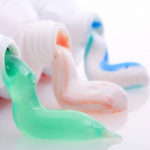
With so many options in the dental health isle choosing toothpaste can be a little overwhelming. From baking soda, whitening, foaming, desensitizing, tarter control, anti-gingivitis, fluoride…the list can go on and on. No matter the brand always select a toothpaste with the American Dental Association (ADA) seal of approval. Dr. Tillman has a few tips for choosing the right toothpaste for you and your family’s needs.
- Anti-cavity: Almost all the options on the market contain fluoride. Fluoride is just as important as brushing in preventing decay and it actively strengthens tooth enamel.
- Anti-gingivitis: Do your gums suffer from redness and bleeding? You might have gingivitis, a mild form of gum disease. Anti-gingivitis toothpastes help reduce oral bacteria and can be very effective at stopping this gum condition at its source.
- Desensitizing: Ever take a sip of hot coffee or a cold beverage and feel a shooting pain? This type of toothpaste might help to give you some relief – it helps reduce pain by blocking the tooth’s pain signal to the nerve.
- Tartar-control: As its name indicates, tartar-control toothpaste helps prevent the buildup of tartar. While this product is helpful in slowing new buildup on teeth, a professional dental cleaning is the only way to remove existing tartar and the bacteria it harbors.
- Whitening: Containing polishing or chemical agents that remove surface stains, this toothpaste is able to help maintain the natural color of your teeth.
Signs you might have gum disease
October 9, 2014

If you have been told you have periodontal (gum) disease, you’re not alone. Many adults currently have some form of the disease. Periodontal diseases range from simple gum inflammation to serious disease that can result in major damage to the soft tissue and bone that support the teeth. In the worst cases, teeth are lost.
Symptoms of gum disease include:
- Bad breath that won’t go away
- Red or swollen gums
- Tender or bleeding gums
- Receding gums
- Painful chewing
- Loose teeth
- Sensitive teeth
Any of these symptoms may be a sign of a serious problem, which should be checked out by Dr. Tillman and our hygienists. At your next dental visit the hygienist can check your gums for signs. They will also ask about your medical history to identify underlying conditions or risk factors (such as smoking) that may contribute to gum disease.
Whether your gum disease is stopped, slowed, or gets worse depends a great deal on how well you care for your teeth and gums every day, from this point forward. Dr. Tillman recommends keeping up with your routine exams and cleanings to help prevent and catch early signs of periodontal issues.
How to get your kids to brush their teeth and like it
October 2, 2014
Getting your kids to brush their teeth, yet alone like it, can be tricky. We have some tips that might help you to get your kids brushing and like it!!
your kids to brush their teeth, yet alone like it, can be tricky. We have some tips that might help you to get your kids brushing and like it!!
Dr. Tillman recommends that you choose a small, child-sized, soft-bristled toothbrush. Soaking the brush in warm water for a few minutes before brushing can soften the bristles even more. Use a pea sized amount of fluoride toothpaste.
Monkey See Monkey Do: Modeling good behavior is one of the best ways to get your kids excited about brushing their teeth instead of thinking it’s a chore. When you brush your teeth, be happy that you’re doing it. If Mom and Dad make it look like fun, the kids will want to do it too. Let them copy you. Buy them the same color toothbrush as you have, or try an electric one, which may be more entertaining for them. Let them try brushing your teeth and then you can brush theirs to make sure they’re actually clean.
Give them a good story: Talk about why we need to brush – how the sugar bugs make holes in our teeth if we don’t brush them away. Sometimes kids need a reason or a good story to get on board.
Make bubbles: Encourage them to create lots of bubbles – that means they’re brushing well. You could hold a bubble-making contest with your kids to see who can create the most bubbles.
Make sure to bring your kids in for their routine check ups and cleanings and our hygienists can help encourage the kids with good brushing habits!
Gum Chewers Rejoice!
September 18, 2014
When  it comes to chewing gum, it’s the type of gum you chew that makes a difference in whether it’s helpful or harmful to your teeth. While chewing gum containing sugar may actually increase your chances of developing a cavity, there is evidence that demonstrates just the opposite for sugar-free gum. And there’s even better news when it comes to chewing sugar-free gum that is sweetened with xylitol.
it comes to chewing gum, it’s the type of gum you chew that makes a difference in whether it’s helpful or harmful to your teeth. While chewing gum containing sugar may actually increase your chances of developing a cavity, there is evidence that demonstrates just the opposite for sugar-free gum. And there’s even better news when it comes to chewing sugar-free gum that is sweetened with xylitol.
Sugar-free gum helps to clean teeth:
Studies have shown that chewing sugar-free gum after meals and snacks can help rinse off the acids released by the bacteria in plaque, which are harmful to tooth enamel. Both the act of chewing and the flavor of the artificial sweeteners in the gum stimulate ten times the normal rate of saliva flow. Not only does the increased saliva flow neutralize the acids in your mouth, it also washes away food particles, helping to keep your teeth clean.
Xylitol reduces decay-causing bacteria:
Sugar-free gum sweetened with xylitol has the added benefit of inhibiting the growth of oral bacteria that cause cavities. In the presence of xylitol, the bacteria lose the ability to adhere to the tooth, stunting the cavity-causing process. With xylitol use over a
period of time, the types of bacteria in the mouth change and fewer decay-causing bacteria survive on tooth surfaces.
To chew or not to chew:
Although chewing sugar-free gum can be beneficial in most instances, there are some cases in which chewing gum is not recommended. For example, if you are experiencing any type of jaw pain you should refrain from chewing gum and talk to Dr. Tillman about what options are available to you.
For most people, chewing sugar-free gum (especially gum sweetened with xylitol) can be a good preventive measure in
situations when toothbrushing and flossing aren’t practical, but sugar-free or not, chewing gum should never replace good dental hygiene practices.
With all these options waiting at the checkout candy rack, it is easier than ever to satisfy your sweet tooth and protect it from cavities at the same time. The next time you are in the mood for a sweet treat, why not bite into a piece of sugar free or cavity-fighting gum that is good for your teeth instead of a sugar-filled candy? Your teeth will thank you.
Is Bottled Water Bad for My Teeth??
September 11, 2014
 Is Bottled Water Bad for My Teeth??
Is Bottled Water Bad for My Teeth??
Millions of Americans are embracing a healthy lifestyle and turning to bottled water as part of their diet. Bottled water is often marketed as being better for you, but it may be doing your teeth a disservice. Your bottled water could be missing some elements that promote oral health.
Fluoride (which many communities have added to their water supply), battles dental cavities by strengthening tooth enamel and re-mineralizing teeth damaged by acid. Unfortunately, the majority of bottled waters contain little or no fluoride.
If you’re deviating from your fluoridated community water supply, you may need to improvise to get your daily fluoride content. You can discuss your water sources, along with the appropriate level of fluoride you and your family should be getting, with Dr. Tillman. If you just can’t go back to the tap, Dr. Tillman may recommend a fluoride toothpaste or prescribe fluoride drops to help meet your needs.
The next time you buy a bottle of water or use a filtration system, think about your teeth, too. Fluoride helps prevent cavities, and since dental health is linked to overall health, you’ll want to take the right steps to keep your mouth in great shape. Talk to Dr. Tillman about the benefits of fluoride, and include dental care in your plans for a healthy lifestyle. After all, you’ve worked hard for that body –why not have a great set of teeth to go with it?
Warning Signs of Impacted Wisdom Teeth
September 4, 2014
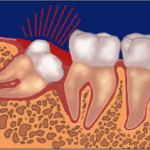 Warning Signs of Impacted Wisdom Teeth
Warning Signs of Impacted Wisdom Teeth
Wisdom teeth, or third molars, are the last teeth to develop and appear in your mouth. They typically come in between the ages of 17 and 25, a time of life that has been called the “Age of Wisdom.” These teeth can often grow in crooked, sideways, or otherwise misaligned. As they grow in, they can push on other teeth, causing problems of overcrowding.
When wisdom teeth come in, they can be painful. You’ll feel wisdom teeth pain at the back of your mouth, behind your molars. If you look into a mirror, you may even notice that your wisdom teeth have begun to poke through your gums. The area might also be red, enflamed and tender to the touch. However some people don’t have any visible symptoms of wisdom teeth pain.
When a tooth doesn’t fully grow in, it’s called “impacted”–usually unable to break through the gums because there isn’t enough room. About 90% of people have at least one impacted wisdom tooth.
An impacted wisdom tooth can damage neighboring teeth or become infected. Since it’s in an area that’s hard to clean, it can also invite bacteria that lead to gum disease. In some cases, a cyst can form around the base of the impacted tooth, which can lead to more serious problems.
Dr. Tillman recommends removing them when there are infections and/or periodontal (gum) disease, cavities that can’t be restored or there is damage to neighboring teeth and overcrowding. This is a common procedure that Dr. Tillman performs in the office and typically only a few days of rest are needed before returning to your normal routine.
Alternatives to Tooth Extraction
July 3, 2014
If you have a damaged or diseased tooth, extraction is not the only option. When possible, it is always best to save your teeth rather than lose them. Missing teeth may have negative effects on confidence, ability to chew, general health and oral health and the alignment of the remaining teeth. Consider the following treatment options before opting for an extraction.
Root Canal:
Root canal remains the most popular alternative to extraction. A root canal procedure is performed when the nerve of the tooth becomes infected or the pulp becomes damaged. During a root canal procedure, the nerve and pulp are removed, and the inside of the tooth is cleaned and sealed.
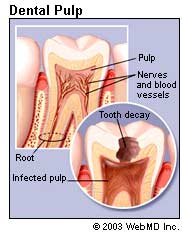
Dental Implants:
A dental implant is an artificial tooth root that is placed into your jaw to hold a replacement tooth or bridge. Dental implants may be an option for people who have lost a tooth or teeth due to periodontal disease, an injury, or some other reason. The implant emulates the shape of the root and is usually made of titanium and other materials that are well-suited to the human body. The implant is surgically placed into the jaw and incorporates into the bone over time to become a stable base for crowns. Dental implants have been used for several decades by patients of all ages. They can replace a single tooth, several teeth or support partial or full dentures.
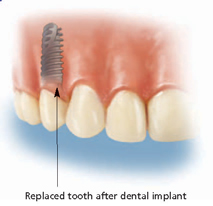
Apicoectomy:
An apicoectomy, or root-end resection, which is occasionally needed when inflammation or infection persists in the bony area around the end of your tooth after a root canal procedure can also be performed to save a tooth. In this microsurgical procedure, the dentist opens the gum tissue near the tooth to see the underlying bone and to remove any inflamed or infected tissue. The very end of the root is also removed. A small filling may be placed to seal the end of the root canal and few stitches or sutures are placed to help the tissue heal. Over a period of months, the bone heals around the end of the root. Local anesthetics make the procedure comfortable, and most patients return to their normal activities the next day. Postsurgical discomfort is generally mild.
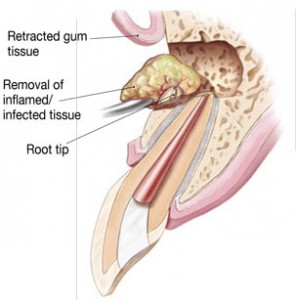
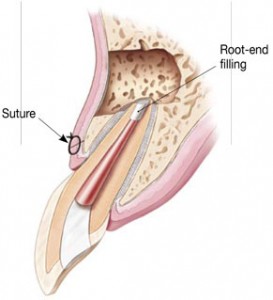
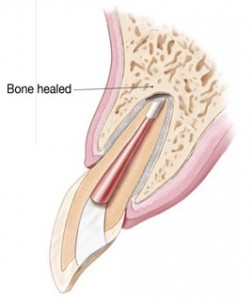
Are there any other options?
For replacement of an extracted tooth, you may also consider a bridge or removable partial denture. These options require additional dental procedures on adjacent healthy teeth, and should be discussed with your dentist or specialist. Check with our office to discuss any concerns or if you just want more information.
